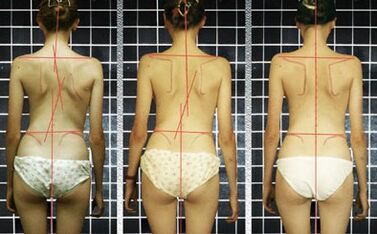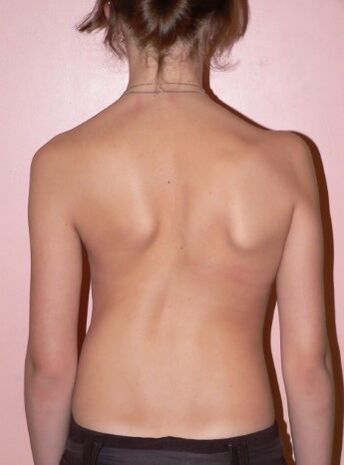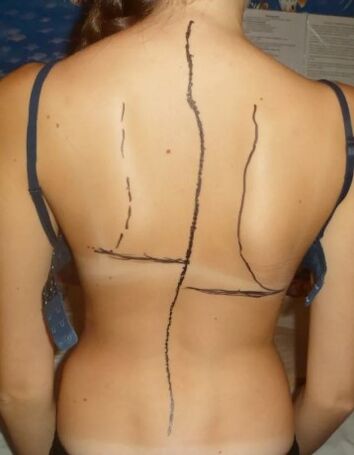The Greek has the word "scolios", which translates as "crooked".With the term, doctors reflect the curvature of the spinal column.In addition, not all curvature, ie lateral deviation of the vertical axis of the spine.The fact is that our spine is generally not completely.The bending available in the back and forth (Lordos and Kiffosis) protects our spine from excessive weight, while maintaining the body in a certain position and carrying weight.Negative processes in our body develop only in cases where these kyphoses and lordoses are expressed more than permissible ideal.

Main problems
However, even a small degree of lateral twist (scoliosis) of the spine is always a pathology.And the point is not only in a cosmetic defect.Although a specific response appearance with clear or progressive scoliosis is always a tragedy for a person who wants to live a high -quality life.This is especially true for young boys and girls.In fact, it is diagnosed with children and young periods (up to 15 - 16 years) that is diagnosed with a significant part of scoliosis.
The main problem is that due to the configuration of the chest with obvious lateral curvature, the internal organs always suffer (heart, lungs, stomach, liver, intestines, large ships).In men, tolerance towards physical exertion decreases, women have problems with conception, pregnancy and childbirth.In addition, very often the lateral deformation of the spine is just the surface part of the iceberg, which is a sign of very severe pathology - tumor, tuberculosis, endocrine disorders.
Reason
So why is the spine distorted?Before answering the question, you should decide on the types of scoliosis.At its core, scoliosis can be structural and uncontrolled.Structural scoliosis develops due to physical changes in the structure of the bone tissue of the vertebrae, as well as located near the muscles, veins and ligament mechanisms located nearby.Such curvature can be achieved and congenital, and a quarter of all diagnosed scoliosis accounts for the latter.
In the main causes of development of structural scoliosis, they distinguish:

- Masts of intrauterine development are leading to displastic disorders of one or more vertebrae
- Congenital chest development abnormalities - lack of ribs, excess ribs
- Congenital deformity of connective tissue - neurofibromatosis, Marfan syndrome
- Brain failure due to children's cerebral paralysis (cerebral palsy)
- Richets in rickets
- Fracture
- Dystrophia
- Tuberculosis damage to vertebrae
- spinal injuries
- Spinal tumors.
Non -static scoliosis is very much as follows, the lateral deviation of the axis of the spinal column with unchanged structure of the vertebrae.As a rule, such scoliosis is often acquired with the exception of cases where curvature is compensated in nature, which is compensated in nature with congenital physiological defects of pelvis or lower loops.Such scoliosis causes most often:
- Pelvic injuries and lower ends
- Innate defects of pelvic and lower loops
- Constant inappropriate currency in school children
- Anktopathic
- Muscle inflammation
- Burns, softened cloth marks on one side.
In these cases, to eliminate the curvature of the spine, it is enough to cure the underlying disease, and therefore many uncontrolled scoliosis are easily reversible.In this regard, some doctors do not generally consider uncontrolled deformity for scoliosis.

Recently, cases of development of scoliosis have become more frequent with vague reasons.It is so -deediopathic scoliosis.This occurs in young years, during the period of rapid development of the body.In addition, girls suffer from idiopathic scoliosis many times compared to young men.Obviously, this is due to the relatively weak muscle behind the female, which is not able to engage the spine into a full muscle frame.A common passion for young people with low calcium salts, and a common passion for young people with carbonated drinks does not play the final role in the development of idiopathic scoliosis.As you know, carbon dioxide in synthetic inclusion and carbon dioxide in orthoporic acid contribute to the baying of calcium salts from the body.
Varieties and degrees
Depending on localization, scoliosis may be cervical, chest, lumbar or mixed (cervical, long).It is possible to have one or more curvature arc.In this regard, C-shaped scoliosis (with 1 arch), S-shape (with 2 arcs) and Z-shaped (with 3 arcs) are distinguished.Most likely, the presence of 2 or 3 arcs is comfortable.With C-shaped scoliosis, the axis of the spinal column deviations.In an attempt to compensate for this, the spine bends in the opposite direction.In this regard, scoliosis is divided into compensation and incompatible.In compensation spinal curvature, a vertical line below the 7th cervical vertebrae passes through the fold between the buttocks.
The curvature of the spine is often combined.For example, in the thoracic region, in addition to lateral curvature, pathological kiffosis is noted, or simply a hump.In these cases, talking about thoracic kifoskolyosis.In addition, with a large degree of scoliosis, thuria is noted, in addition to the lateral displacement of the vertebrae.In a literal translation, it means twisted.Indeed, with many scoliosis, the vertebral bone tissue is twisted with the vertical axis.
Depending on the size of the angle of the arc of curvature, 4 degrees of scoliosis are distinguished:
- 1 degree- The angle of curvature does not exceed 10 degrees.Eye inequality is practically not determined.Stoop, the uneven level of the shoulder waist, pays attention.
- 2 degrees- The angle of curvature ranges from 11 to 25 degrees.In this limit, the vertebra has already been noted.There is an asymmetry of the shoulder girdle and pelvis that appears on the eye.Due to the stress of the pathological muscle, the formation of a muscle roller is formed from the concave side in the area of the lumbar, and in the chest area with a convex.
- 3 degrees- Wrtification ranges from 26 to 50 degrees.Visual deformation of the chest - The intercostal space in the concave side of curvature is emerged with western and convex.Weakening the abdominal press, formation of an internal hump.
- 4 degrees- The angle of curvature is more than 50 degrees.A cosmetic defect and all previous signs are expressed.Even the low tolerance of small physical exertion.In addition to the musculoskeletal system, internal organs suffer.

The angle may vary depending on the condition of the body, while the stable and unstable scoliosis is distinguished.With unstable scoliosis, it decreases in a state of lies when the load on the spinal column decreases.With a stable curvature of the spine, this value remains unchanged.
symptoms
Recently, orthopedists often use the term "scoliotic disease".And they indicate a complex of negative changes in the body during curvature of the spine.As a rule, during the formation of musculoskeletal systems, scoliotic disease develops in childhood and adolescence.At this time, there is a high probability that scoliosis will progress.
Obviously, intervertebral discs play an important role in increasing the angle of curvature.With a side displacement, the disc experiences uneven pressure from vertebral bodies.On the concave side, this pressure is high, with a convex - low.As a result, discs more wears from disc scoliosis, a pathological muscle tension (muscle roller) and vertebrae of vertebrae - all of these disk leads to further increase in the appearance and angle of curvature of the disk hernias.

With a spine with a scoliotic disease, the chest changes for the second time.SO -Called Rib Hump is formed - on the convex side of the curvature, the intercostal spaces expand, and from the concave - on the contrary, they are sown.With scoliosis of the 4th degree, the deformation of the chest is so clear that the lower ribs on the edge of the curvature are in contact with the rowing of the illicit bone.
Due to severe deformation of the chest, a complete excursion during breathing is difficult.As a result, the body with severe scoliosis does not receive the required amount of oxygen - SO -Cronic chronic hypoxia develops with a violation of all metabolic processes in the body.Pathology increases by the fact that the internal volume and shape of the chest cavity changes.Because of this, blood circulation through ships is disturbed, lungs suffer, heart size changes, chronic heart failure develops.
Similar changes occur in abdominal organs for lumbar and lumbosacral scoliosis.The stomach and intestinal motorithin decreases with subsequent enzymatic insufficiency of the digestive glands.All this only increases metabolic disorders.These violations often cause sexual maturity to boys and girls.In addition, due to scoliosis of the wood, the pelvis is a second time curved.This causes problems with conception and delivery for future mothers.
Diagnosis
Diagnosis of scoliosis, especially large degrees, is not difficult, as a rule.To detect the deformation of the spine, a general visual examination is often sufficient.The visual curvature of the spinal shape, the asymmetry of the shoulder girdle, the angle of the shoulder blade, the secondary curvature of the pelvis and the lower limb on the edge of curvature are notable.
In the presence of at least one of these signs, radiography of the spinal column is indicated.The X -Ray determines the configuration, degree and localization of curvature.During inspection and radiological examination, it is possible to establish whether scoliosis has been compensated and stabilized.Recently, a qualitative new method of research of the spinal cumbers resonant imaging (MRI) has spread, during which a three-dimensional image of the spine can be obtained on the monitor screen.With significant curvature, it is necessary to check the work of the internal organs - a spirometry, to complete the electrocardiography, and carrying an ultrasound of the heart and internal organs.
Treatment
Scoliosis can be treated both conservative and immediately.Orthodox methods include drug treatment, massage, physiotheraputic procedures and manual therapy.It should be kept in mind that the final formation of the spine is finished by the age of 20, and after this age, the improvement of curvature is almost impossible.With scoliosis of 1-2 degrees, the effort is aimed at achieving the initial, general configuration of the spine.With clear scoliosis of 3 - 4th degree, it is unattainable, the main thing here is to stabilize the spine and prevent the progression of scoliosis.

In the treatment of scoliosis, drugs (chondroprotectors, vitamins, normal strengthening drugs) play only a supporting role.To strengthen the muscles, eliminate the muscle roller, and even to a large extent to stabilize the spine with the help of massage and manual therapy.A good effect is given by physiotherapy exercises.But here, with insufficient physical exertion, the volatility of the spine is increased and scoliosis moves forward.Therefore, a set of exercise is developed individually for each patient, taking into account the localization and severity of curvature.With a large degree of scoliosis, running, strength exercise, jump, outdoor games are contraindicated.
A very good result improves by the position - the optimal posture is formed which contributes to the normalization of the currency.For this, special equipment is used, orthopedic cribs in which young patients spend a significant part of their time.With the ineffectiveness of conservative measures, surgical treatment is indicated aimed at the progression of curvature, stabilizing the spine.Surgical improvement is not shown in childhood, it is done in adolescence, when the spine is almost complete.



















































